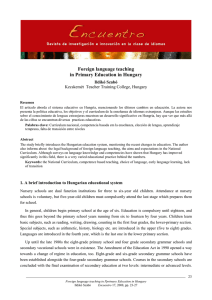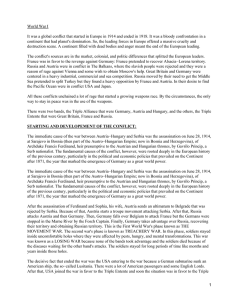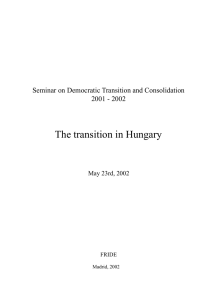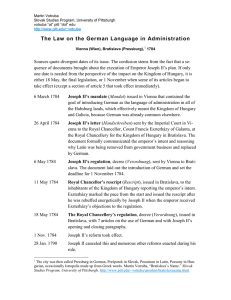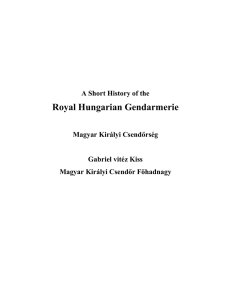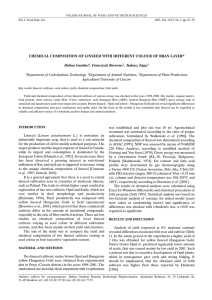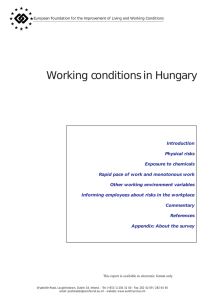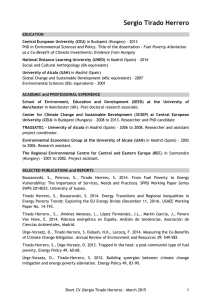Hungarian Attempts at the Annexation of Slovakia in 1938 (Part I)
Anuncio
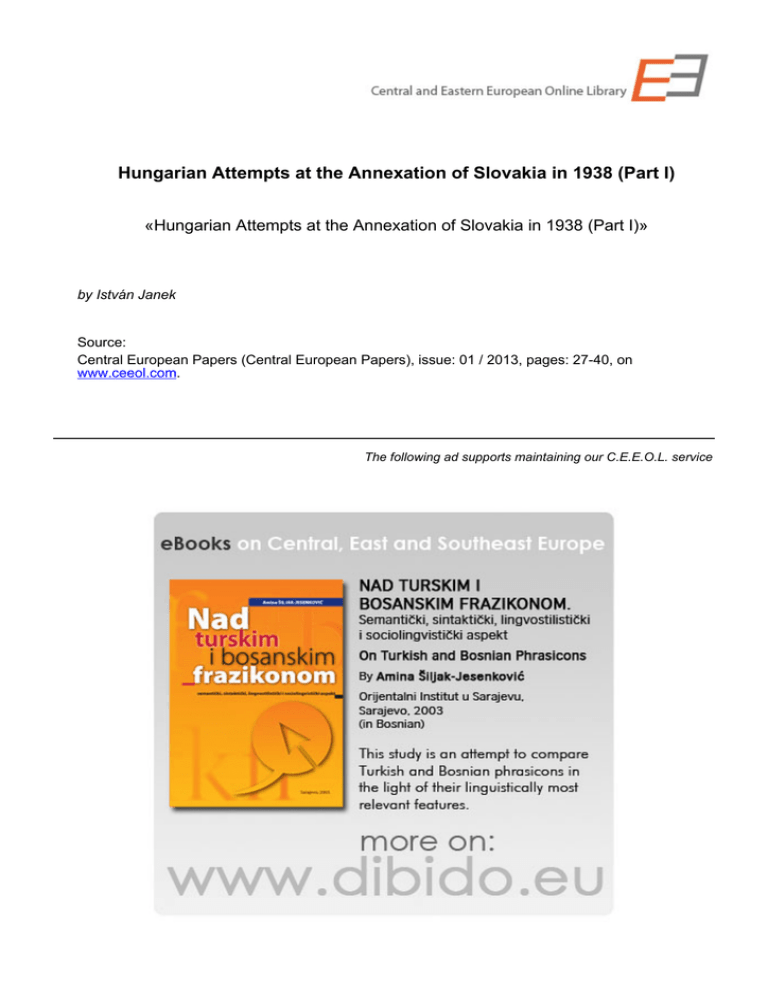
Hungarian Attempts at the Annexation of Slovakia in 1938 (Part I) «Hungarian Attempts at the Annexation of Slovakia in 1938 (Part I)» by István Janek Source: Central European Papers (Central European Papers), issue: 01 / 2013, pages: 27­40, on www.ceeol.com. The following ad supports maintaining our C.E.E.O.L. service CENTRAL EUROPEAN PAPERS 2013 / I / 1 27 Hungarian Attempts at the Annexation of Slovakia in 1938 (Part I) István JANEK Magyar Tudományos Akadémia, Bölcsészettudományi Központ, Történettudományi Intézet Research Centre for the Humanities, Hungarian Academy of Sciences, Budapest, Úri u. 53, 1014 Budapest, Hungary janek.istvan@freemail.hu In my study, I tried to give an objective illustration of the diplomatic activity the Hungarian government carried on in order to get Upper Hungary from the beginning of 1938 to the first Viennese arbitration. My aim was not to do justice, instead, I intended to give a more tinged picture of the time by the revelation of events through Czech and Slovak sources. For the Hungarian government, rejecting the revision proposal of Hitler’s Germany applying for the whole of Slovakia, the only solution acceptable also for the four major European powers was the alternative of ethnic revision in 1938. Between the two world wars, the idea of acquiring Upper Hungary became the objective number one regarding Hungarian revision, engaging the attention of both the political and military circles. In 1938, it seemed to be possible that their aim might be realized. In 1938, it was obvious that Czechoslovakia had become the ‘sick man’ of Europe. The German-Czechoslovak crisis had deepened and war seemed to be at hand. Hungarian views concerning Czechoslovakia changed accordingly. Hungarian society and the government never approved of the loss of the northern region populated by Hungarians and Slovaks, just as they never accepted the loss of other territories of the former Kingdom of Hungary. They endeavoured to regain those territories during the interbellum years. The annexation of Slovakia was in the focus of Hungarian revisionary thought, cherished by both political and military circles. Hungarian politicians especially resented the loss of Upper Hungary, second only to the loss of Transylvania, because this region had played an essential role in the economy of the Kingdom of Hungary. What is more, a part of the political elite had several links with the region due to their origins or former estates. Hungarian propaganda implied that since Czechoslovakia had no historical traditions as a state, it would be the easiest target to break up in order to regain the lost territories. In their view, Czechoslovakia was an artificial construction which could thank the great powers for its existence, and therefore could be defeated relatively easily in an appropriate moment.2 Hungarian government circles did not look at the birth of Czechoslovakia as the unification of the Slavonic population of Hungary with their mother country. They consistently denied that the Slovaks and the Czechs formed one nation. Thereby they denied the Czechoslovak 1 It is a novelty in my work that author used hitherto unknown Slovak and Czech sources, which provided a new approach to the events. 2 The necessity of revision was self-evident for the Hungarian politicians and the public. They would not approve of the situation made by the Trianon Treaty. Miklós ZEIDLER, Magyar revizionizmus a két háború között, in: Limes 14, 2001, 3, 10–11. Access via CEEOL NL Germany 28 István JANEK Hungarian Attempts at the Annexation of Slovakia in 1938 (Part I) state theory, which regarded the two ethnic groups as two branches of the same nation. For two decades, the Hungarian government endeavoured to prevent the Slovaks and the Czechs from establishing closer links. For them, the Slovaks were an ethnic group, which was subjugated by the Czechs and was, therefore, struggling for liberation together with other minorities. They held that the Slovaks formed an entirely separate nation in terms of ethnography, language and historical development. The Hungarian leadership shared the view that Slovakia, or at least the territories populated by Hungarians, had to return to Hungary. They believed that Slovaks and Ruthenians would vote for their unification with Hungary in a referendum. In order to popularise this idea, they secretly subsidized the Slovak movements led by František Jehlička3 and Viktor Dvorčák.4 The Hungarian government set up the Slovak Central Bureau (Tót Központi Iroda) and the Slovak Department (Tót Főosztály) next to the Ministry of Nationalities. The aim of these institutions was to lead Slovakia, or a part of it, back to Hungary on certain conditions5. The Hungarian leadership, in order to have an influence on the Hungarian public as well, broadcast the propaganda in the 1930s that the Slovaks had already regretted not joining Hungary in 1918, and they wanted to redress their mistake, but they could not do it overtly in Czechoslovakia.6 Hungarian governments between the wars regarded gaining the support of the great powers of Europe to the idea of revision as their main task in foreign policy. Makers of Hungarian foreign policy did their best to lead their country out of her isolated position and to get allies for the territorial revision. Germany seemed to be the best supporter of this case. Revision for the Hungarian government meant what they called ‘integral’ revision,7 that is, the retaking of all the land that had formed the Kingdom of Hungary. It was only in the second half of the 1920s that ethnic revision8 was considered, and it was handled as a different solution.9 Integral revision was taken off the agenda of the Hungarian government as a plan without any real chance to be realised. Peaceful revision became a slogan from 1928. By the mid1920s, the Hungarian governments had made it clear also for the leaders of the 3 František Jehlička (Ferenc Jehlicska; 1879–1939), Slovak politician, Catholic priest and university professor. He was elected member of the Hungarian parliament in 1906 but he resigned from his seat shortly afterwards. He attended the Paris Peace Conference with Andrej Hlinka in 1919, where they wanted to speak up for Slovak autonomy, but their plan did not work. From then on, he worked in service of the Hungarian government in several European cities, working on Slovak autonomy and the union of Slovakia and Hungary. For more about Jehlička see: Miroslav MICHEĽA, František Jehlička politikai pálfordulatai 1918–1920-ban, Pro Minoritate, 2005, 32–44; Marián HERTEL, František Jehlička. Nočná mora politického života, in: Do pamäti národa, Slavomír MICHÁLEK – Natália KRAJČOVIČOVÁ a kol., Bratislava 2003, 263–266. 4 Viktor Dvorčák (1878–1943) Slovak-born politician, formerly director of the archives in Sáros county. After Trianon, he worked for the Hungarian government, under the pseudonym Szőke Költő (Blond Poet). Some sources also mention him as Dvorčák (Dvorcsák) Győző. He spread propaganda for the creation of an autonomous Slovak state within Hungary both in Hungary and abroad for decades. Miroslav MICHEĽA, Pod heslom integrity. Slovenská otázka v politike Maďarska 1918–1921, Bratislava 2009, 26–31. See Juraj KRAMER, Iredenta a separatizmus v Slovenskej politike, Bratislava 1957, 18; Miroslav MICHEĽA, Maďarská politika a plány ozbrojenej akcie na Slovensku v rokoch 1919–1920, in: Vojenská História 12, 2008/2, 67. 5 Marián HRONSKÝ, Boj o Slovensko a Trianon 1918–1920, Bratislava 1988, 225–226. 6 Lajos STEIER, Felsőmagyarország és revízió, Budapest 1933, 32; István BORSODY, A magyar–szlovák kérdés alapvonalai, Budapest 1939, 37–38. 7 The notion of the restoration of the pre-Trianon Kingdom of Hungary. 8 The notion of regaining the Hungarian-populated areas. 9 László SZARKA, A kisebbségi kérdés a magyar–csehszlovák kapcsolatokban, in: Regio 1, 1990, 3, 236–237. CENTRAL EUROPEAN PAPERS 2013 / I / 1 29 Hungarian minorities that they considered territorial revision the only satisfactory solution.10 Still, there were some in-between ideas as well: a possible referendum was mentioned, for instance, about the territory of Slovakia with the support of the great powers, but this could not get any serious consideration. Reunification and referendum, the plan of a common Hungarian-Slovak state remained among the plans of certain Hungarian politicians; some regarded it as the initial step on the path of revision until as late as 1938. István Bethlen and Pál Teleki were the two Hungarian politicians who definitely tried to implement ethnic revision in Czechoslovakia.11 After the First World War, Hungarian leaders hoped that the Slovak elite would eventually adopt a pro-Hungarian attitude and Slovakia would join Hungary. Although there were attempts to realise this plan, it could not be considered a practicable solution in the second half of the 1930s. Hungarian diplomacy did everything to win over Andrej Hlinka12 and his party to their cause. Their attempts were frustrated by the Vojtech Tuka trial,13 in which they lost the man who could have influenced Hlinka and Tiso.14 Vojtech Tuka thought at first that Slovakia should unite with Hungary but he changed his mind during the years of his imprisonment, and he let a Hungarian agent know about it in 193915. The Hungarian government tried other ways as well: Jehlička and Dvorčák tried to gain Slovak politicians through the organisations that they founded and through other Slovak emigrants. These movements did not have significant influence on the Slovak population; their movements lost their social base after initial successes in the 1920s. Still, the Hungarian administration expected them to establish cooperation with the Slovak People’s Party led by Andrej Hlin10 On the inner situation of the Hungarian population in Slovakia see: Attila SIMON, A szlovákiai magyar politika és Dél-Szlovákia a két világháború közötti kolonizációja, in: Integrációs stratégiák a magyar kisebbségek történetében, Attila SIMON – Nádor BÁRDI (eds.), Somorja 2006, 261–276; Béla ANGYAL, Érdekvédelem és önszerveződés, Galánta – Dunaszerdahely 2002. 11 Jörg K. HOENSCH, Die Slowakei und Hitlers Ostpolitik, Köln – Graz 1965, 63. 12 Andrej Hlinka (1864–1938), Slovak politician, Catholic priest. He started his political career in the Catholic People’s Party, later joined the Slovak National Party and became the leader of its clerical wing. From 1905 the founding president of the Slovak People’s Party. Member of Parliament. In 1919, he asked the Paris Peace Conference in a note to grant autonomy for Slovakia within Czechoslovakia, and therefore the Czech authorities deprived him of his seat in parliament and imprisoned him for eight months. Later he became the leading figure of the Slovak autonomy movement against the Czech centralising attempts. His successor and the new leader of the movement was Jozef Tiso. 13 Vojtech Tuka (1880–1946), lawyer, university professor, politician. He taught at the academy of law in Pécs and later at the University of Bratislava. He took part in the Hungarian secret military organisation and the establishment of the Hungarian political parties in Czechoslovakia. He joined Hlinka’s Slovak People’s Party, in which he became deputy president and, from 1925, the representative of the party in the parliament. He drafted the first autonomy plan of the party. In 1929, the Czechoslovak authorities arrested him as a Hungarian spy and sentenced him for 15 years in prison. He was released by amnesty in 1937. In the Tiso government, he was deputy minister, Foreign Minister and Prime Minister. He was executed as a war criminal in 1946. 14 The Slovak-Hungarian cooperation was hampered by the Tuka trial, which revealed, even though no evidence was shown, that Tuka had received money and commission from the Hungarian government for spying. See: Tímea VERES, A Tuka-per közvetlen előzményei a cseh és szlovák sajtóban, in: Fórum-Társadalomtudományi Szemle 6, 2004, 1, 149–153; Tímea VERES, Tuka politikai visszatérése, in: Fórum-Társadalomtudományi Szemle 9, 2007, 2, 87–100; Michal LUKEŠ, Cesta k amnestii Vojtecha Tuky, Historický časopis 46, 1998, 4, 663–672. 15 Tuka said in the first half of 1939 that he could do nothing to facilitate the annexation of Slovakia by Hungary. Then the Hungarian diplomacy wrote him off as an agent. Juraj FABIAN, Svätoštefanské tiene Telekiho zahraničná politika a Slovensko 1939–41, Bratislava, 1966, 31, 91. 30 István JANEK Hungarian Attempts at the Annexation of Slovakia in 1938 (Part I) ka. Hlinka and his circle, however, rejected cooperation with Jehlička and Dvorčák from the second half of the 1920s. Direct approaches of the Hungarian government had no perceptible result, either. The alternative for Hungary after the Anschluss was either to come to some agreement with the Little Entente and give up the idea of revision, or to participate in the German actions against Czechoslovakia. Although Hungarian politicians saw the growth of German power with anxiety, non-interference in the dissolution of the Czechoslovak Republic was out of the question from foreign and domestic aspects alike. The Hungarians understood that they had to negotiate with the leadership of the Slovak People’s Party, Hlinka and Jozef Tiso if they wanted to get Slovakia.16 Hungarian diplomacy realised that Poland needed a common Hungarian-Polish border due to the growing threat from Germany. The fall of Czechoslovakia might end in the German occupation of the whole country. Polish and Hungarian politicians regarded this option as a fatal consequence, which is to be prevented at any rate. Therefore, Warsaw observed the national movements in Czechoslovakia, among them the breakaway attempts of the Slovaks, with content and supported them. The Polish government always supported the Hungarian side in the Czechoslovak-Hungarian conflicts. Hungarian-Polish attempts to approach Slovak leaders From March 1938, Hungarian diplomacy sought the opportunity to start negotiations with Slovak leaders. As Czechoslovakia still existed at that time, talks had to be held in secret, and they required a mediating party. They made use of the fact that the Poles had talks with Slovak leaders at the beginning of 1938. The Polish foreign minister, Józef Beck sent the message to Hungary17 that they could make progress in the Slovakian question only if they built honest connections with the leaders of the Slovak People’s Party and Karol Sidor.18 The Hungarian ambassador to Prague, János Wettstein asked for the opinion of the Hungarian Foreign Ministry in his letter of 2 March. The response of the ministry (7 March) pointed out that Hungary would grant autonomy not only to the Slovaks but also to the Ruthenians if they return to Hungary. The degree of autonomy would depend on the circumstances of their return. If the Slovaks cooperated in the breakup of Czechoslovakia, they would receive greater autonomy; otherwise they could expect limited autonomy. The letter also mentioned that other friendly states would participate in a military action19 (Poland and Germany were implied although not named). Polish activity raised Hungarian worries: perhaps the Poles also had territorial claims in Slovakia, which had hitherto been regarded 16 Magda ÁDÁM, A müncheni egyezmény létrejötte és Magyarország külpolitikája 1936–1938, Budapest 1965. Diplomácia iratok Magyarország külpolitikájához 1936–1945, II (hereinafter referred only as DIMK, II), 369–370 (doc. no. 187). 17 Ibidem, 339–340 (doc. no. 160). 18 Karol Sidor (1901–1953), Slovak politician and journalist. The rival of Jozef Tiso in the Hlinka party and politics in general. Member of the National Assembly from 1935. From 1 December 1938, deputy Prime Minister in the Prague government. In March 1939, the last Prime Minister of the Slovak government in Czechoslovakia. From 1939–1945, the ambassador of Slovakia to the Vatican. He emigrated to Canada after 1945. 19 KRAMMER, 290. CENTRAL EUROPEAN PAPERS 2013 / I / 1 31 as a purely Hungarian sphere of interest. This seemed to be justified by the fact that news started to spread in the Polish press and the public about a possible Polish annexation of Slovakia. The Poles expressed that they did not want the territory; the only purpose of this news was to facilitate the inner disintegration of Czechoslovakia.20 The Polish general staff also enquired about the Hungarian plans. They wanted to know where the Hungarians wanted to draw the border of Hungary and of the Slovak autonomous territory as well as the Hungarian intentions concerning the Carpathian region.21 The Hungarian diplomacy informed the Poles in a letter sent by Foreign Minister Kálmán Kánya on 15 May 1938 that they claimed only Slovakia and the Carpathian region but not the little pieces that were ceded to Poland after the First World War.22 This seemed to settle the territorial disputes between the two countries by and large although some uncertainty remained sensible. In mid-May 1938, Hungarian diplomacy asked the Poles for mediation with Slovakia. The Polish Foreign Minister, Józef Beck met with Karol Sidor in Warsaw on 19 May and told him that if Czechoslovakia fell apart, Hungary had to annex Slovakia. Beck also pointed out to the Hungarian ambassador in Warsaw, András Hory, that the Slovak leaders were distrustful towards Budapest, and therefore the Hungarian diplomacy should approach Slovak leaders as soon as possible. The Poles made it clear that they wanted to assure the Slovaks that they had no claims for Slovakia. They said, that “[…] they did the utmost effort to secure tranquillity in the region, which is possible only if Budapest satisfies the demands of the Slovaks, who are awakened to an independent nationhood, for self-government”.23 The Hungarians wanted to find out about the Polish plans, and they sent Colonel Rezső Andorka, a leader of the intelligence department of the Hungarian General Staff to collect information at the end of June 1938. Andorka had talks with the Head of Staff of the Polish army, General Wacław Stachiewicz, in which he wanted to know if the Hungarians could count on Polish military intervention against Czechoslovakia in case of a German attack, and if so, with what strategic objectives. Stachievicz did not give a clear answer; he merely said that they would act as their national interests demand. He mentioned though, that the Poles designated two different zones in Slovakia: the Carpathian region, which was important only as much as the most appropriate place for the common Polish-Hungarian border but the Poles had no further interest in the area. The other zone was the Slovakian populated territories. Here, Stachevicz said, also the wishes of the Slovak nation must be considered as a prerequisite of long-lasting or final settlement. Andorka had the impression that the Poles might have some special agreement with the Slovaks, whose details remained unknown. Andorka also led talks with Tadeusz Kobylański, the head of the political department of the Polish Foreign Ministry and asked him about the Polish territorial demands. Kobylański let 20 DIMK, II, 369 (doc. no. 187). 21 The question of the Carpathian region was important for the Poles due to the Ukrainian movement, which had been being organised. The Poles were afraid that a Ukrainian movement in the Sub-Carpathian area could lead to the formation of a Ukrainian Piedmont, and from there the significant number of Ukrainians in Poland could be organised into a revolt. To avoid this, they would welcome Hungarian control over this territory. 22 DIMK, II, 383 (doc. no. 200). 23 Ibidem, 246 (doc. no. 447). 32 István JANEK Hungarian Attempts at the Annexation of Slovakia in 1938 (Part I) him know that they formed claims for Teschen24 and a few Polish villages in Orava25 and the Spiš26. He emphasised that Polish diplomacy endeavours to get the Slovaks to accept the Hungarian version. He asked the Hungarians that in case of, or even before, a referendum in Czechoslovakia, to do effort to attract the Slovaks with propaganda.27 Now, Andorka thought that the Poles were open to cooperation with Hungary but he did not exclude that they had some hidden intentions with Slovakia and could have larger territorial demands.28 These worries proved ill-founded later. János Esterházy, the leader of the Hungarians in Slovakia, also got involved in the Polish-Hungarian talks.29 He maintained good connections with high-rank Slovak and Polish politicians, and therefore he played an important role as a mediator. He wanted to create a Catholic Polish-Slovak-Hungarian bloc in Central Europe, which could, in his view, resist German advance more effectively. Esterházy wanted to know to what extent the Poles would support Hungarian plans with Slovakia. Karol Sidor represented the Polish orientation in the Slovak People’s Party, so he was the first for Esterházy to contact. Esterházy assured Sidor that Hungary did not intend to deploy military force against Slovakia but wanted to hold talks with Poland about the creation of a common border between Poland and Hungary in the Carpathian region.30 Later Esterházy also protected the interests of the Slovaks at the Hungarian government by emphasising that he would be willing to mediate between Hungary and Slovakia only if the Hungarian government did not repeat its former mistakes and did not want to abuse the Slovaks. He found the annexation feasible only in agreement with the wish of the Slovak people and he rejected the use of force in any way. Esterházy suggested that the Hungarian government should grant the Slovaks as many minority rights in the would-be Slovak constitution as possible but certainly more than the Czechs had given before.31 János Esterházy had talks with Beck and his deputy, the foreign secretary, Count Jan Szembek, about the plans with Slovakia on 17 and 18 July 1938. Beck informed Esterházy that the collapse of Czechoslovakia was at hand and it would be the consequence of domestic tension rather than foreign pressure. “Hitler wants to avoid war at any rate, and therefore he chose the method of inner disintegration, which will be thoroughly done by Konrad Henlein32 24 In Czech known as Těšínsko. 25 In Hungarian known as Árva. 26 In Hungarian known as Szepesség. 27 Ibidem, 252 (doc. no. 468–470). 28 Ibidem, 470. 29 János Esterházy (1901–1957), politician. He was elected member of the National Assembly in 1935. After the unification of the two Hungarian parties in Czechoslovakia, the managing president of the party from July 1936. After the First Vienna Award, he remained in Slovakia and became president of the Hungarian Party. In 1942, he was the single member of the Slovak parliament to vote against the Jew law. After the war, he was imprisoned in Czechoslovak and Soviet prisons until his death. 30 Pavel ČARNOGURSKÝ, 6. 10. 1938, Bratislava 1993, 105. 31 Diariusz i Teki Jana Szembeka (1935–1945), Jozef ZARONSKI (ed.), Vol. IV, London 1972, 189, 192. 32 Konrad Henlein (1898–1945), Sudeten German politician. He established the Sudeten German Patriotic Front movement in 1931; it was organised as a party in 1935. With the support of Hitler’s Germany, he caused a domestic political crisis and, with the increase of the Sudeten German national demands, he helped the minority question in Czechoslovakia to mushroom into a European problem. CENTRAL EUROPEAN PAPERS 2013 / I / 1 33 and his fellows.”33 In Beck’s opinion, if Czechoslovakia falls apart, the whole of Slovakia will have to be returned to Hungary. Beck spoke about this to Karol Sidor as well, whom he assured that they would receive wide autonomy from the Hungarians. Sidor responded that they were not afraid of the Hungarian population in Slovakia, as they understood each other, but they were worried about the behaviour of the Hungarians in Hungary. Esterházy explained to the Polish leaders as well as to Sidor that the Hungarians did not want to repeat their former mistakes, and the annexed Slovakia would possibly not be governed from Budapest but local authorities would receive significant power. He gave the example of Croatia in the Austro-Hungarian Monarchy with its autonomous position. He had the view that the Slovaks would be granted a high degree of domestic and foreign autonomy with their own parliament and extended power. Only foreign, financial and economic affairs would be handled together. As for territorial questions, only the Carpathian region and the parts of Slovakia with Hungarian majority would be annexed by Hungary. Esterházy also raised a new point: Poland could guarantee the observance of the Slovak constitution promised by the Hungarian government.34 Beck, in his endeavour to facilitate the Hungarian-Slovak approach, also offered to Sidor, and the other Slovak leaders through him, that they could negotiate in Warsaw rather than Budapest, should they be worried about the Czechs35. Neither the Poles nor Esterházy managed to get Sidor to support the Hungarian proposal; the politician fiercely attacked the Hungarians in ‘Slovák’, the Bratislava daily in its issue of 31 July. Sidor found it ridiculous that Hlinka and the Slovaks would want to join Hungary or any other country. He emphasised that the Slovaks “do not want the Hungarians, they do not believe them and the return to Hungary is out of the question. […] As we survived the age of the Romans, the Huns, the Hungarians and other, so shall we live and hold out”.36 Sidor also pointed out in his article that only the Czechs and the Jews were satisfied with their situation in Czechoslovakia. The Slovaks did not want to form a Czecho-Slovak nation, only a Slovak. He protested in the article that the Slovaks were not even acknowledged as a nation in his country. The Hungarian diplomacy took Sidor’s words seriously and they thought they had better continue the talks with Josef Tiso. Hungarian-Slovak unification talks in 1938 In the second half of 1938, Slovak politicians made plans with new elements regarding the form of government in Slovakia for the case if Czechoslovakia should fall apart or should be occupied. These political combinations were based on the idea that the year 1938 would have as great impact on European affairs as 1918 had had, that is, significant territorial changes could be expected in the region. They counted on the unification with a neighbouring country in order to avoid the destruction of the Slovak nation. They imagined the 33 DIMK, II, 457 (doc. no. 250). 34 ZARONSKI, IV., 189–190, 194. 35 DIMK, II, 457 (doc. no. 250). 36 Magyar Nemzeti Levéltár Országos Levéltára (The State Archives of the Hungarian National Archives; hereinafter referred only as MNL–OL), Foreign Ministry (hereinafter referred to only as KÜM), K 63, 64. csomó (hereinafter referred to only as “cs.”), doc. no. 2541/pol. 1838. 34 István JANEK Hungarian Attempts at the Annexation of Slovakia in 1938 (Part I) unification by forming a federation or union. Andrej Hlinka mentioned it to a Polish diplomat, as early as April 1938, that they would possibly break with the Czechs and that they were ready to cooperate with the Poles. Tiso and others wanted to achieve that the Poles support the recognition of the Slovaks as a political nation or possibly their autonomy or even their independence. They even mentioned the formation of a Polish-Slovak union but this idea did not receive serious attention.37 The Slovak politicians also held talks with the Hungarians. Hungarian diplomacy welcomed the news that Andrej Hlinka said to his followers in his political testament on his death bed in August 1938: “As soon as there is time and opportunity to break away from the Czechs, I leave it to Karol Sidor, who is the most competent representative of the will of the nation and myself, to negotiate with the Hungarian government about the Slovaks’ unification with Hungary bearing in mind the conditions of autonomy, which result from the programme of our party.”38 No documents have remained about the talks between Hlinka and the Hungarian government so the political testament cannot be proven. Hungarian diplomacy realised as early as the beginning of 1938 that Hlinka’s most powerful man, and his possible successor, would be Jozef Tiso, and therefore they were trying to come to an agreement with him in the question of Slovakia. The secret talks took place at the 34th Eucharistic World Congress in Budapest at the end of May 1938.39 Tiso, the new president of the Slovak People’s Party, was a participant priest, so he could meet with the Hungarian Foreign Minister, Kálmán Kánya without attracting attention. Tiso said that the Slovaks were willing to establish a common state with Hungary after their secession from the Czechs. Their talks continued until the end of September 1938.40 Tiso summarised his conditions in three points: “1. Central office with executive power for the administration of Slovakia and the use of Slovak as official language; 2. A separate parliament as legislative power for domestic affairs, religion and public education; 3. Budget quota.”41 The Poles also found out about the Slovak-Hungarian talks, and the Hungarians responded that “[…] no final decision has been made yet but the negotiations are going in a favourable atmosphere”.42 Tiso visited Edvard Beneš in Prague on 23 September 1938, of which he informed the Hungarian government. With his trip, he wanted to prevent the Slovak leadership from splitting into factions, and to refute the charge that he did not take every opportunity to reach an agreement. He asked, therefore, the Hungarian government not to interpret his visit to Prague as delaying tactics, but “they have to show a friendly face towards Prague, otherwise they are in danger of being slaughtered”.43 He also asked the Hungarian leaders not to flood Slovakia with Hungarian officials after the unification as they were not familiar with the local circumstances and they could soon elicit resentment in the Slovak population. 37 Poland gave the Slovaks no answer regarding the union. See: Pavel ČARNOGURSKÝ, Deklarácia o únii Slovenska s Poľskem z 28. októbra 1938, in: Historický časopis 16, 1968, 3, 416. 38 Naša Zastava, 4. 2. 1940, 3. 39 MNL–OL, K 63, 63 cs., doc. no. 1938, 7/1. 40 DIMK, II, 665–666 (doc. no. 403). 41 Archiv Ministerstva zahraničních věcí, Praha (The Archives of Ministry of Foreign Affairs, Prague; hereinafter referred only as AMZV), Zahraniční úřad (hereinafter referred only as ZÚ) Budapesť, box no. 20, doc. no. 352. 42 DIMK, II, 596 (doc. no. 337). 43 DIMK, II, 645–646 (doc. no. 388). CENTRAL EUROPEAN PAPERS 2013 / I / 1 35 Although the Hungarian government accepted Tiso’s conditions, the Slovak-Hungarian negotiations ended without success. In the opinion of Ambassador András Hory, they could not come to an agreement because Kánya did not trust Tiso.44 Kálmán Kánya said these words about the intentions of the Slovak politicians: “the Slovaks, it seems, continue their double game. While Sidor makes apparently pro-Czech statements, Tiso have summarised his wishes for the case of their unification with Hungary in three points in the past days.”45 Ferdinand Ďurčanský,46 later Slovak Foreign Minister, described the Slovak opinion about the Hungarians like this: “[…] the Slovaks were afraid that their attempt to gain autonomy would be interpreted by the Hungarians as the return of the Slovaks to Hungary. What has been written down or said in connection with the cooperation with the Hungarians can be regarded as a means to put pressure on the Czechoslovak policy.”47 To put it clearly: they considered it as a tactical step and rejected the idea of unification. The Hungarian-Slovak talks ended without success; still, they continued in secret.48 Hungarian-German-Polish negotiations about the future of Slovakia A Hungarian delegation travelled to Germany led by the Regent Miklós Horthy on 21 August 1938. The bilateral talks took place in an unfriendly atmosphere because the representatives of the Hungarian government had made a contract with the representatives of the Little Entente in Bled, Slovenia, on 20 August, in which the latter acknowledged equal rights for Hungarian rearmament.49 Simultaneously, the Hungarian delegation signed contracts with Romania and Yugoslavia about a more effective realisation of the rights of Hungarian minorities in the two countries. Hitler resented these Hungarian steps. The Bled agreement disguised the Hungarian intention to break the unity of the Little Entente in some way. It was the continuation of the old Hungarian policy which by no means aimed at reconciliation with the Little Entente. In their view, this was the most important precondition to any further steps. The Germans did not, or would not, understand the Hungarian intentions. Therefore the talks in Kiel started in an uneasy atmosphere. The German Foreign Minister, Ribbentrop explained to Kánya that Hungary had made the realisation of her revisionist demands against Czechoslovakia impossible with the agreement.50 Kánya endeavoured to belittle the Bled talks. The Hungarian-German negotiations became re44 András HORY: Bukaresttől Varsóig, Pál PRITZ (ed.), Budapest 1987, 252. 45 DIMK, II, 665 (doc. no. 403). 46 Ferdinand Ďurčanský (1906–1974), Slovak politician and lawyer. Member of the National Assembly as a delegate of the Slovak People’s Party. Editor of the paper Nástup. Minister in Tiso’s autonomous government from 7 October 1938 to 9 March 1939. Foreign Minister of the Slovak state until 1940. He did not take any significant office after this. In 1945, he escaped to the West; he was sentenced to death in default. One of the leaders of Slovak emigration until his death. 47 Ferdinand ĎURČANSKÝ, Pohlaď na slovenskú politickú minulosť, Bratislava 1943, 205. 48 HOENSCH, 64. 49 On the Bled and Kiel negotiations, see: Pál PRITZ, Magyar diplomácia a két háború között, Budapest 1995, 296–333; Thomas L. SAKMYSTER, Hungary, the Great Powers, and the Danubian Crisis 1936–1939, Athens 1980, 175–184. 50 Akten zur deutschen auswärtigen Politik 1918–1945 (hereinafter referred only as ADAP), Serie D, Baden-Baden 1950, II, no. 383, 486–487. 36 István JANEK Hungarian Attempts at the Annexation of Slovakia in 1938 (Part I) ally tense when the Germans asked for Hungary’s military participation in the operations against Czechoslovakia, and they expected prompt agreement. They adhered to the military solution as the only practicable one; they did not consider that any international talks could bring success in this question. Horthy assured the Germans about Hungarian cooperation but only on certain conditions. The Hungarians did not think the German military action properly timed. Kánya also expressed to Ribbentrop that the armament of Hungary was only in an initial stage, and they could not risk war against the well-equipped Czech army. Kánya also said to Göring a few days later that if there had been 60–70% chance for success against the Czechs, they would take the risk, but the Germans could not expect Hungary to commit suicide.51 He rejected participation in military action by referring to the weakness of the army; the question of Hungarian military participation could not have come into serious consideration anyway.52 Ribbentrop asked Kánya pointedly about the Hungarian viewpoint in case of a possible German-Czech military conflict. Kánya responded by emphasising the neutrality of Hungary.53 The German leaders offered to acknowledge Hungarian claims for the whole of Slovakia, including the Carpathian region in case of Hungary’s participation.54 The Hungarians rejected this idea. Horthy said to Hitler that Hungary would not force revision with arms. The Führer told the Hungarian delegation that “however, who wants to sit at the table, must at least help with the cooking”.55 The Hungarian government, fearing a western intervention, rejected Hitler’s demands,56 that is, the Kiel talks failed to bring any success. However, the Hungarians tried to keep the German alliance alive, and therefore they gave some economic concessions. They were afraid that their attack on Czechoslovakia would turn the Little Entente as well as England and France against them, and a military conflict like that could end only with the defeat of Hungary. They wanted to satisfy their territorial demands in a peaceful way. Hungarian politicians counted on a long preparatory period, and they were not prepared for a military action against Czechoslovakia. They wanted to isolate Czechoslovakia with the Bled agreement but the events got further, and now they had to think about whether or not they should participate in an invasion planned by Germany. In mid-September 1938, disturbances began in the Sudetenland in Czechoslovakia, backed by the German intelligence. Representatives of the Sudeten Germans contacted János Esterházy and called the Hungarians to join their movement. They said it could bring about the revision of the Trianon Treaty. Esterházy rejected cooperation and said: “The Hungarian Party does not join the struggle of the Sudeten Germans, which can initiate a new world war. The incidents provoked by you will be bloodily revenged by the Czechoslovak army. If the Hungarians joined the Sudeten initiative, Hitler would declare himself our protector as well and could use it as a pretext to attack Czechoslovakia. In this way, we would be 51 ADAP, D, II, 402, 519. 52 Magda ÁDÁM, Magyarország és a kisantant a harmincas években, Budapest 1968, 223; Mária ORMOS, Magyarország a két világháború korában, Debrecen 1998, 178. 53 György RÁNKI, Ervin PAMLÉNYI, Loránt TILKOVSZKY, Gyula JUHÁSZ, A Wilhelmstrasse és Magyarország (hereinafter referred only asWilhelmstrasse) Budapest 1968, 287–288. 54 Elemér ÚJPÉTERY, Végállomás Lisszabon, Budapest 1987, 60. 55 Documents on German Foreign Policy 1918–1945, D, Vol. II, Washington 1949, 611. 56 Martin HETÉNYI, Slovensko-maďarské pomedzie v rokoch 1938–1945, Nitra 2008, 14. CENTRAL EUROPEAN PAPERS 2013 / I / 1 37 the cause of the outbreak of the war. We do not want it by any means. We do not want to enforce the revision of the Trianon Treaty with a war.”57 Esterházy also expressed, on behalf of his party, that the Hungarians imagine revision in a peaceful and democratic way. The Sudeten Germans responded that “You are a pacifist, Mr Esterházy! Through your pacifist attempts you will never achieve the revision wanted by the Hungarian minority”.58 Esterházy wrote in response that the Hungarian minority and the state of Hungary would benefit more from giving up revision than from enforcing it through a second world war. About the unification of Slovakia and Hungary, Esterházy explained that he could only imagine it without violence and with the consent of the Slovak people. In his view, the unification would take place on a dualist model, just like the connection between Croatia and Hungary in the Austro-Hungarian Monarchy, with separate government, parliament, budget and with an army subordinate to the Hungarian government.59 Esterházy did not stand alone with his attempt for peaceful revision. It occurred to several Hungarian politicians that the price for German orientation and revision could be too high. Pál Teleki expressed his worries in confidential circles: “We will perish with the revision; it will involve us in war. We get back Upper Hungary, all right, also Ruthenian; these we can deal with, adopt, administer. […] If Transylvania returns, we will be obliged to the Germans forever, who will then demand the price. And the price will be war on their side; the country herself will be the price of revision.”60 Esterházy soon realised the dangers of forceful revision, that is also why he supported agreement with the Slovaks in future, and he was not happy about the involvement of the great powers, which, he thought, would use this issue to their own purposes. Göring called the Hungarian ambassador in Berlin, Döme Sztójay to him on 17 September 1938, and said to him that “here is the decisive moment”61 to demand the rights of the Hungarian minority. He asked the Hungarians to issue a proclamation similar to the call of Konrad Henlein as well as the provocation of armed clashes. He saw this to be the only way to direct the attention of the great powers to the Hungarian claims. The purpose of the Germans was to show the inviability of the Czechoslovak state. The only thing the Hungarian politicians did was to set up the Ragged Guard (Rongyos Gárda) in secret, with the organisation of the former Minister of the Interior, Miklós Kozma. This group was to be deployed in the Carpathian region for sabotage actions and to organise a general rebellion.62 The United Hungarian Party sent a proclamation to the Czechoslovak government on 17 September 1938, in which they called for self-determination and right for a referendum for the Hungarian population in Czechoslovakia. The Hungarians thought that the Slovaks would take a similar step. A Slovak demand for referendum, and consequently the unification with Hungary would have served the interest of the Hungarian revision. However, the supporters of Slovak autonomy did not want unification with Hungary. The Polish government asked the Hungarian government again for information about the 57 Lujza ESTERHÁZY, Szívek az ár ellen, Budapest 1991, 86. 58 Ibidem. 59 Imre MOLNÁR, Sem gyűlölettel, sem erőszakkal. Esterházy János élete és mártírhalála, Komárom 2008, 72. 60 Miklós ZEIDLER, Mozgástér a kényszerpályán. A magyar külpolitika „választásai” a két háború között, in: Romsics Ignác szerk: Mítoszok, tévhitek, hiedelmek a 20. századi magyar történelemről, Budapest 2002, 193. 61 DIMK II, 619 (doc. no. 361). 62 Mária ORMOS, Egy magyar médiavezér: Kozma Miklós. II., Budapest 2000, 552–563. 38 István JANEK Hungarian Attempts at the Annexation of Slovakia in 1938 (Part I) Hungarian-Slovak talks. Their exaggerated interest concerning Slovakia raised the suspicion of the Hungarians again about Polish territorial claims. Therefore they sent Rezső Andorka to Warsaw once again to meet with military leaders. He talked with the Head of Staff, Wacław Stachiewicz, just as before. The Polish general explained that the Poles had no interest in former Upper Hungary but he added: unless the Slovaks asked for their assistance. However, he declared clearly that they wanted no territory from the Carpathian region, as they had enough problems with their own Ukrainians. Andorka said that the Hungarian government could explain some modification of the borders in favour of Poland. Stachiewicz responded that the Slovaks must not be divided or dismembered; Slovakia must remain in one piece wherever she should get. Andorka clearly asked that if Hungarian troops had marched in Upper Hungary, where could they meet Polish troops, or if Poland considered a joint Polish-Hungarian military operation possible for the invasion of Upper Hungary. Stachiewicz rejected this idea and added that they did not want to send troops to Upper Hungary. Andorka’s endeavour to bring together military cooperation fell through.63 Hungarian diplomacy was hoping to come to some agreement with the Slovaks. This is mirrored in the letter of Foreign Minister Kálmán Kánya to the Hungarian ambassador in Warsaw, András Hory, in which he writes about the Slovak leaders: “We share the view that the Slovaks play a half-hearted double game, but we hope that the forthcoming events will make them come to a firmer standpoint.”64 In his cipher telegram of 19 September 1938, Kánya informs Hory about the talks with the Slovaks: “[…] the present leaders of the Slovaks cannot make a clear decision despite the fact that we have offered them extended autonomy.”65 Kánya asked Hory to inform the Poles that if Czechoslovakia starts to disintegrate from within, they demand a referendum only in the Hungarian-populated territories, but in this case they would support the secession of the Slovaks and the Carpathian region as well. In Kánya’s views “The Slovaks still maintain the view that they receive considerable autonomy in the Czech state and they grant the Hungarians similar rights.”66 Kánya asked the Poles to try to make the Slovaks understand that “the Czech state is doomed to die”, and therefore it would be important that they unite with Hungary in case of a possible referendum. The Poles suggested that they should talk over the Slovak proposal of autonomy together and then they would guarantee its observance. The Hungarian Foreign Minister answered in a reserved voice: “The Slovak autonomy guaranteed by Poland is a most problematic question, which must be handled very carefully from the viewpoint of the sovereignty of Hungary and the development of a friendly Polish-Hungarian relationship.”67 Kánya only promised to inform Poland about the progress of the negotiations, and that they would accept the Slovak claims for autonomy at any rate. The Hungarian government did not succeed in coming to an agreement with the Slovaks until mid-September 1938 in spite of the Polish mediating attempts. Hory talked with Beck as well about the Slovak question, 63 DIMK, II, 589–590 (doc. no. 331). 64 Ibidem, 616 (doc. no. 358). 65 Ibidem, 623 (doc. no. 364). 66 Ibidem. 67 Ibidem. CENTRAL EUROPEAN PAPERS 2013 / I / 1 39 who assured him that they would endeavour to get the Slovaks to turn towards Hungary. “He also said that they had no selfish intentions in the Slovak question, and they acted only in the interest of Hungary.”68 The Poles informed Hory on 22 September that they had given orders to their ambassador in Prague and their consul in Bratislava to warn the Slovak autonomist politicians that they had to decide on their union with Hungary, as the Hungarian-populated territories would be cut off, which would cause serious economic difficulties for Slovakia.69 The notion was shared both in Warsaw and in Budapest that thanks to the ever deteriorating minority situation and foreign pressure, there would be no other option for the Slovaks but to join Hungary. On 20 September, Hitler met with Hungarian Prime Minister, Béla Imrédy and Foreign Minister Kánya in Obersalzberg. He said that the appropriate moment had come for Hungary to attack Czechoslovakia while he was talking with the British Prime Minister Neville Chamberlain. Hitler here repeated his offer for the division of Czechoslovakia. The Hungarian politicians gave an evasive answer because they did not want to start war.70 The Hungarian government did not give up the struggle for Slovakia: they dispatched the former emigrant Slovaks, Jehlička and Dvorčák. Both asked, on behalf of the Slovak National Council, that the Slovak question would be discussed at the conference of the great powers. At the meeting of Godesberg on 22–23 October 1938, they asked the German and English delegation to tackle the Slovak question as well and support the initiatives for a referendum. Jehlička had already drafted a memorandum for the Hungarian government in Geneva a month before on 21 September 1938. He pointed out the importance of granting self-determination to the Slovaks, that is, they should be allowed to decide where they wanted to belong. Therefore he asked the Hungarian, the German and the Italian governments to acknowledge the Slovak Council the legal representative of the Slovaks. In Jehlička’s view, all the Slovaks should return to Hungary with extended autonomy. Otherwise they would be exposed to the interests of the Czechs. He mentioned this as a danger: “The Czech population would flow to Slovakia from the territories to be annexed, and they would devour Slovakia and turn it to Czech territory.”71 Jehlička said that the Slovak people had never wanted to secede from Hungary and it was their only desire to return to their old home, under the crown of St Stephen. Moreover, he asked for the diplomatic and military help of the Hungarian government.72 He advised the Hungarians to turn to the Germans, the Italians and the Poles for help. About the Poles he added that it should be asked only in case the Germans and the Italians do not help. Since there were a few among the Slovaks who would orientate themselves to Poland, Jehlička thought it possible that the Poles bring territorial claims in return for their help, which Hungary would be incapable of satisfying. Hungary had a thousand-year historical right to have the whole of Slovakia, which they must not give up. Jehlička, in order to confirm his own position, showed himself as the one 68 Ibidem, no. 372 (doc. no. 631). 69 Ibidem, no. 381 (doc. no. 638). 70 On the talks see: SAKMYSTER, 198–200; Wilhelmstrasse, 297–298. 71 MNL–OL, KÜM, K 64, 79 cs., doc. no. 172/biz. 1938. Jehlička, the memoir of the President of the Slovak Council to Kálmán Kánya. 72 Ibidem. 40 István JANEK Hungarian Attempts at the Annexation of Slovakia in 1938 (Part I) who is to complete the political testament of Hlinka and to continue his policy.73 The efforts of Jehlička and Dvorčák were not taken seriously by the western powers. The Germans and the Italians, however, to support the Hungarians, regarded them as negotiating partners and held unofficial talks with them. Jehlička was even received by Benito Mussolini. Abstract Hungarian society and the government never approved of the loss of the northern region populated by Hungarians and Slovaks, just as they never accepted the loss of other territories of the former Kingdom of Hungary. They endeavoured to regain those territories during the interbellum years. The annexation of Slovakia was in the focus of Hungarian revisionary thought, cherished by both political and military circles. Hungarian politicians especially resented the loss of Upper Hungary, second only to the loss of Transylvania, because this region had played an essential role in the economy of the Kingdom of Hungary. Hungarian propaganda implied that since Czechoslovakia had no historical traditions as a state, it would be the easiest target to break up in order to regain the lost territories. In their view, Czechoslovakia was an artificial construction which could thank the great powers for its existence, and therefore could be defeated relatively easily in an appropriate moment. After the Anschluss in 1938, the Hungarian diplomacy tried to negotiate a potential incorporation of Slovakia to Hungary based on autonomy with Slovak political representatives. Polish foreign policy representatives acted as mediators in these talks. On the other hand, Josef Tiso and his political mates wanted to achieve that the Polish, German and perhaps the Hungarian leadership support the recognition of the Slovaks as political nation, possibly their autonomy or directly their independence. Also Slovak politicians held secret negotiations with the Hungarians. From the Slovak party, the negotiations with the Hungarians could be regarded simply as tactics, but they rejected it indeed, thus these talks ended without success. Keywords History, Hungarian revision, Hungarian-Slovak relations, Slovak autonomy, Hungarian-Polish relations, 1938 73 Jörg K. HOENSCH, Der ungarische Revisionismus und die Zerschlagung der Tschechoslowakei, Tübingen 1967, 99.
